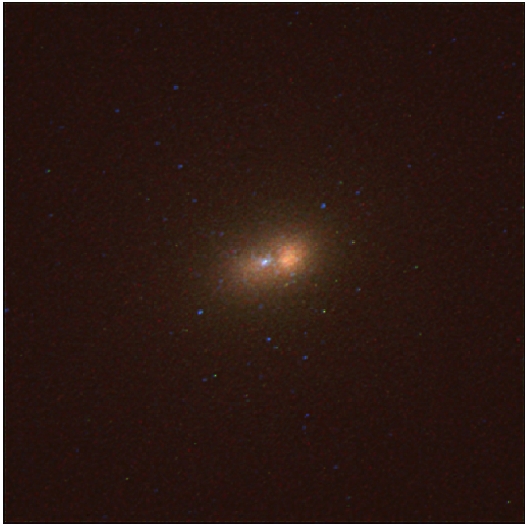
| Images of Black Hole Galaxies |
|---|
In a ground-based search using the Canada-France-Hawaii Telescope, I and my collaborators found central dark objects - probably supermassive black holes - in M31, NGC 4594, NGC 3115, NGC 3377, and NGC 4486B. "Clickable" images of these objects and a brief summary of the observations are given below. Links are given to the original papers, which provide more detail.

Color image of the double nucleus of M31 (the Andromeda Galaxy) constructed from Hubble Space Telescope WFPC2 exposures in I, V, and 3000 A bandpasses obtained by (Lauer et al. 1998, AJ, 116, 2263). The left brightness peak (with embedded blue star cluster) is P2; the right peak is P1. The I- and V-band images were substepped by half of a PC pixel, so the scale is 0.0228 arcsec/pixel. This figure is from Kormendy and Bender (1999, ApJ, 522, 772). In this paper, we present arguments that the 30 million solar mass black hole is in the embedded blue star cluster. Photo credit: John Kormendy (University of Texas at Austin) and Ralf Bender (University Observatory, Munich, Germany)
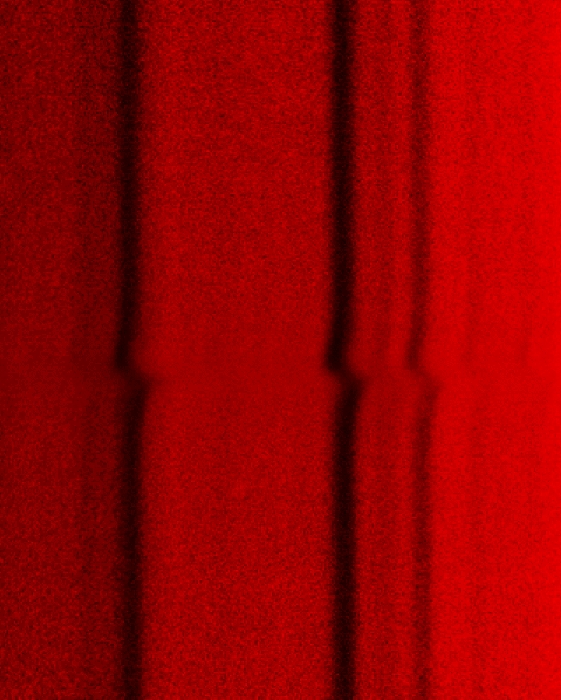
Signature of the black hole in the observations. Since a black hole is dark, we cannot see it directly. Instead, we look for its gravitational effects on ordinary stars around it. If there is no black hole, then the stars move slowly, as dictated by their gravitational attraction on each other. If there is a black hole in addition to the stars, then the gravitational pull from the center of the galaxy is much larger, and the stars must move much faster in their orbits. We observe stellar motions by measuring the redshift or blueshift of dark spectral lines produced by the absorption of light by atoms in the atmospheres of the stars. To see the shifts, we spread the light into its component colors (i. e., into a "spectrum"). The image above is the spectrum of M31 as observed with the Canada-France-Hawaii Telescope. Only a small wavelength range in the near infrared is shown (314 Angstroms centered on three strong absorption lines of Calcium at about 8500 Angstroms). Bluer colors are at right; redder colors are at left, but the color difference is not discernable in this image. Position along the major axis of the double nucleus varies from top to bottom. The image has been "unsharp-masked"; that is, the variation in brightness of the galaxy along the slit has been divided out. This is why the brightness looks the same from top to bottom even thought the galaxy is brightest at the center (i. e., the center of the image). The image is 35 arcsec high. Pixels are 0.982 Angstroms wide x 0.0864 arcsec high. The point-spread function (PSF) of atmospheric blurring has a full width at half of maximum intensity (FWHM) of 0.63 arcsec.
The main body of the galaxy rotates slowly; as a result, the spectral lines are slightly tilted - so slightly that the tilt is not apparent in a casual inspection. However, the nucleus rotates very rapidly. That is, below center, the stars are approaching us at more than 200 km/s and above center, they are moving away from us at almost 200 km/s. Therefore the spectral lines are blueshifted on one side and redshifted on the other side of the center. The rotation is visible as the zigzag in the spectral lines near the center. This is the signature of the black hole. A similar figure centered on the Magnesium lines at about 5175 Angstroms is shown in the original black hole discovery paper (Kormendy 1988, ApJ, 325, 128). That spectrum had a PSF FWHM of 1.22 arcsec. M31 was the second galaxy in which a supermassive black hole was found. M32 was the first: (Tonry 1984, ApJ, 283, L27).
This figure is from Kormendy and Bender (1999, ApJ, 522, 772). Photo credit: John Kormendy (University of Texas at Austin) and Ralf Bender (University Observatory, Munich, Germany)
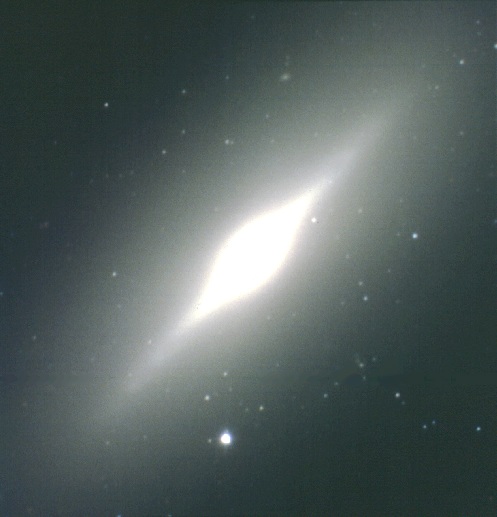
The S0 galaxy NGC 3115 was the 4th galaxy in which a supermassive black hole was found (Kormendy & Richstone 1992, ApJ, 393, 559). This is a true-color image obtained with the Canada-France-Hawaii Telescope. NGC 3115 is well suited to the black hole search: at a distance of only 9.7 Mpc (32 million light years), it is close enough so that the effects of a black hole on nearby stars are easily seen, and it is transparent (no dust) and made of old stars (note the bland color), so the measurements are straighforward. Also, it contains an edge-on nuclear disk of stars. This is important because it means that the dynamics are dominated by rotation. As a result, the central mass can be measured with fewer uncertainties than normal. In fact, the black hole in NGC 3115 was one of the easiest to find, because it is unusually massive compared to the rest of the galaxy. Rapid rotation and large random velocities of the stars near the center imply that NGC 3115 contains a black hole about 1 billion times as massive as our Sun. Photo credit: John Kormendy (University of Texas at Austin)
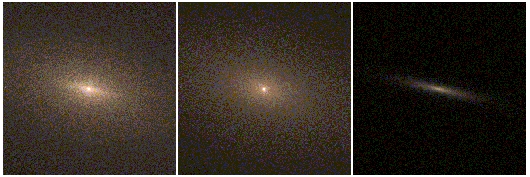
Nuclear disk and brightness cusp of NGC 3115 imaged with the Hubble Space Telescope (HST) by Kormendy et nuk. (1996, ApJ, 459, L57). Brightness is proportional to the square root of intensity; colors are exaggerated slightly to illustrate the lack of dust and large population gradients. All panels are 11.6 arcsec square. These images are rotated with respect to the large-scale image of the galaxy above because HST was oriented arbitrarily during the observations. At left is a color image made from 1050 s V- and I-band images after 20 iterations of Lucy deconvolution. The right panel shows a model of the embedded nuclear disk constructed so that, when it is subtracted from the raw image, the residual image (center) has isophotes that are as close to elliptical as possible. Removing the nuclear disk emphasizes the brightness cusp at the center of the galaxy. This cusp has a velocity dispersion of 600 +- 37 km/s, one of the largest seen in any galaxy. If the nucleus contained only old stars and not a black hole, its escape velocity would be about 350 km/s -- much smaller than the observed velocities of the stars. Independent of any velocity anisotropy, this shows that NGC 3115 contains a central dark object, probably a black hole, of about 1 billion solar masses. This is easily enough to have powered a quasar. Photo credit: John Kormendy (University of Texas at Austin).
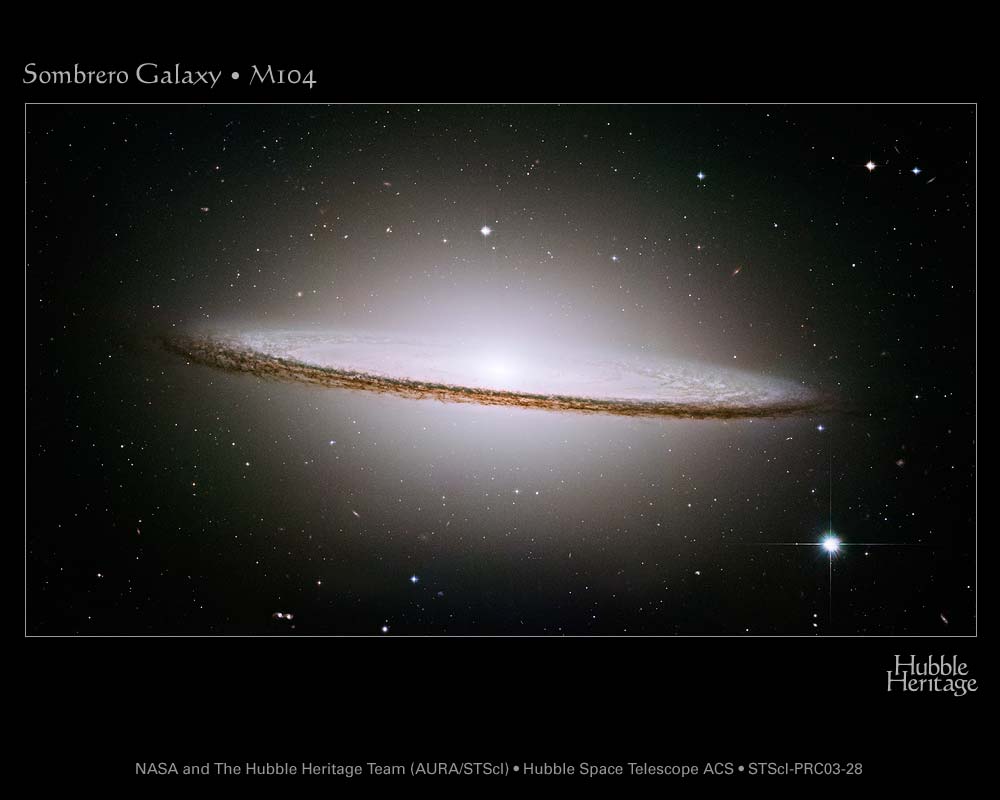
NGC 4594 (The Sombrero Galaxy) was the third galaxy with stellar-dynamical evidence for a supermassive black hole (Kormendy 1988, ApJ, 335, 40) This is a Hubble Space Telescope Hubble Heritage picture; click on it to get the photo credit.
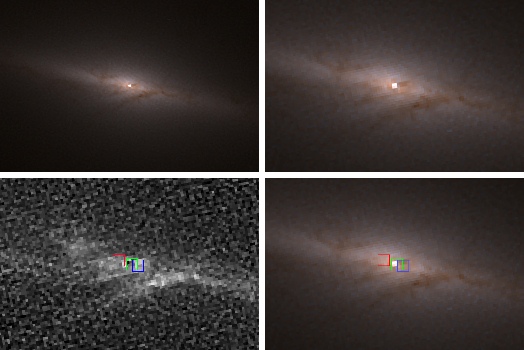
Center of the Sombrero Galaxy as seen with the Hubble Space Telescope (HST) (Kormendy et nuk. 1996, ApJ, 473, L91). This is an approximately true-color image made from 1200 s V-band (green) and 1050 s I-band (red) images after 40 iterations of Lucy deconvolution. To emphasize the dust, the blue image used is an extrapolation from I through V. Displayed brightness is proportional to the square root of the intensity. The upper-left panel is 9.3 x 6.2 arcsec, i. e., it shows an area at the center of the galaxy that is about as big as a medium-brightness star image in the VLT picture. As usual with HST images, the orientation is arbitrary; the embedded nuclear disk is actually aligned with the outer disk. The upper-right panel is the same image expanded by a factor of 2 (4.6 x 3.1 arcsec). The bright spot at the center is not a star cluster; it is a low-powered active galactic nucleus (a mini-quasar). The lower-right image shows the 0.21 arcsec aperture positions used for our HST spectroscopy with the Faint Object Spectrograph. Red indicates the receding side of the galaxy; green and blue indicate the approaching side with respect to the systemic velocity. The lower-left panel shows V - I coded so that V - I = 1.6 is black and V - I = 2.3 is white. Both the V - I image and the color image show an irregular distribution of dust. Fortunately, there is little enough dust so the black hole measurements are not significantly affected. Photo credit: John Kormendy (University of Texas at Austin).
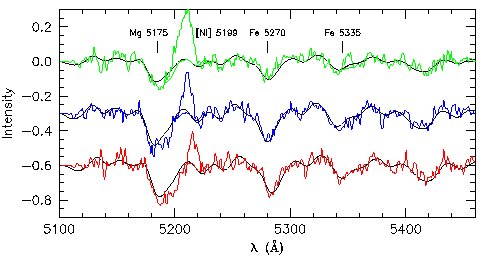
HST spectra of NGC 4594 color-coded as in the images. The spectra are shown before and after the removal of the [NI] 5199 Angstrom emission line produced by the active nucleus. The black lines are a standard star spectrum broadened and velocity-shifted to fit the data. The implied random velocities of the stars near the center are large: the line-of-sight velocity dispersion is 323 +- 22 km/s, 320 +- 11 km/s and 312 +- 11 km/s at radius 0.032 arcsec, 0.163 arcsec, and -0.207 arcsec, respectively. Therefore the HST observations confirm the conclusion from the CFHT spectroscopy that the Sombrero Galaxy contains a central dark object, probably a black hole, of mass about 1 billion Suns. Photo credit: John Kormendy (University of Texas at Austin).
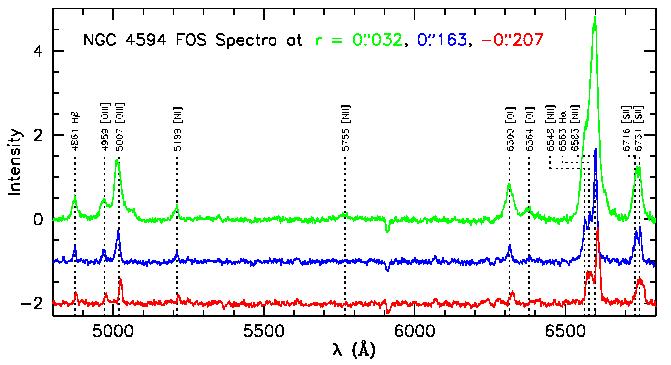
HST emission-line spectra of NGC 4594, color-coded as above. The underlying absorption-line spectra have been removed by subtracting an emission-line-less spectrum of a standard galaxy (NGC 3379) that had been velocity-shifted, broadened, and intensity-scaled to match the absorption-line spectrum of NGC 4594. All lines subtract well except Na I D at 5892 Angstroms rest wavelength (the line is redshifted slightly because the galaxy is moving away from us); the small residual is due to absorption by interstellar dust. The green-coded spectrum at 0.032 arcsec radius includes the active nucleus. NGC 4594 is a Seyfert galaxy: the nucleus contains hot gas moving around the black hole at velocities of ~ 5000 km/s. This is why the emission lines are so broad. It is the signature of the mini-quasar powered by the black hole.
University of Texas Astronomy Home Page
John Kormendy (kormendy@astro.as.utexas.edu)